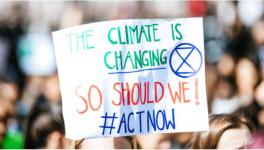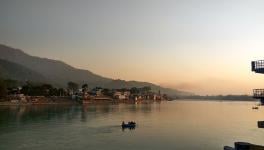‘Cannot Separate Climate Change from Development Process’—Shyam Saran

Representational image. | Image Courtesy: pixabay
Former foreign secretary Shyam Saran was Prime Minister’s Special Envoy and Chief Negotiator on Climate Change between 2007 and 2010. He tells Rashme Sehgal that India can only achieve Prime Minister Narendra Modi’s ambitious net zero carbon emission target by 2070 if it makes significant investments in renewable energy. Edited excerpts.
To what extent will India keep its commitment to reduce carbon emissions?
India has not committed to any reductions in carbon emissions. The commitments are in its capacity to increase renewable energy, which is expected to hike to 450 to 500 gigabytes. We are working towards reducing the emission intensity of our gross domestic product (GDP) growth. The carbon intensity of growth will come down by 45% by 2030 against an earlier target of 33-35% announced in Paris. The Prime Minister has committed India to zero-carbon neutrality, which we will achieve by 2070. Several countries are committed to achieving zero carbon neutrality by 2050, while China has pledged to become carbon neutral by 2060. Given the difference in our economic levels, ours seems to be a good target. How much impact it will have has to be seen. It is an aspirational target, but it played well in the negotiations at COP26. China is presently producing more than 20% of the world’s greenhouse gases, the United States is producing 14%, while India is producing 7%. So, there is a huge gap between India and China. India’s goal to achieve net zero emissions by 2070 is a rather ambitious figure, which has more political significance. A lot can change by then: It is loose-ended, but the commitments made by other nations are also loose-ended.
Will we be able to meet our renewable target by 2030?
So far, our target for renewable has been quite good. We need to put in a lot more effort. India has fairly ambitious plans for both solar and wind energy.
What kind of investment will be required to meet our targets in renewable energy?
I don’t have a figure, but looking at it from the advancements on the technology side, both have costs, but when we compare solar power to thermal power, it makes more sense to go for renewable energy. The economics favour renewable, so I don’t see why we can’t expand it. Look at the coal-based thermal power sector. A large number of the coal-fired plants are over 20 years old and have efficiency levels below 30%. It is better to move towards a more favourable energy composition in the next ten years.
What kind of mix of solar energy can we talk about in India’s context?
The big increase in capacity will come from grid-connected solar power plants. Solar power needs a lot of space. Rajasthan and Gujarat are fast progressing in this field, but given our population, they too will have limited space in the future. Of course, right now, space has not become a major constraint. A lot will depend on future technical developments. The technological challenge will be that for every megawatt of energy produced, less space be used. A significant challenge will be to provide power in remote areas. [Therefore,] it makes more sense to go for rooftop solar power and also large capacity.
What about wind power?
Wind capacity is more limited and has much more variability, so we need to make some balancing power available. In many places, hybrid solutions of integrating renewable with one another are being considered. I believe, in the future, [India] will use hybrid solutions in the interim.
Is green hydrogen power ready for deployment?
Hydrogen energy is not so advanced, nor as proven as solar and wind power. Does hydrogen have the capacity to store power—a battery that can provide predictable and reliable power storage for six to eight hours? Work is going on in this field, but we are not there yet. To produce hydrogen, we need power, and to do that, again, we will need to produce more renewable power. We have not reached a point where we have a feasible alternative to fossil fuels. The transition will take more time.
Funding to less-developed nations has been a vital issue at COP26.
The transition from fossil fuels to renewable energy will need the deployment of large resources. Development in technical capacities to accelerate such a change will also require huge investments. A complete phase-out is therefore not realistic at present.
Is that why Union Environment Minister Bhupender Yadav announced no phasing out of coal but phasing down?
The Indian minister made this announcement at the last session of the conference. China is the largest producer of coal in the world. China and the United States adopted this language [“phasing down”] in their agreement on 10 November. China should have made it [the announcement]. Why should India have agreed to make that declaration when the United States and China were responsible for it?
Why do you think it happened?
I was not there. I don’t know why. In my mind, it was a misjudgement.
Will this changeover away from coal affect our economic growth?
Energy is not a major constraint. The economy is growing more slowly than had been anticipated. The kind of estimates that were there earlier of energy consumption for 8% growth has not occurred. We have a surplus of coal-based thermal power and are presently supplying coal to Nepal and Bangladesh.
If our economic growth starts accelerating, naturally, our energy requirement will go up. What kind of balance should we maintain in renewable and cleaner sources of energy? Should we go for a large-scale increase in nuclear power?
The BJP government seems to have gone quiet over nuclear energy.
Internationally, public opinion has turned against nuclear energy. Political support for nuclear power is much less today. The cost of nuclear power has also gone up. As an aftermath of Fukushima, nuclear plants need to incorporate more safety features. The economics of nuclear power has become negative. We used to look at nuclear power as one of the answers to the energy crisis. It is one of the cleaner sources of energy available. We have technical people available in this field. Work on none of our nuclear plants has stopped, and we are presently collaborating with the United States, France and Russia.
The Prime Minister assured at the beginning of COP26 to end the use of coal, but the India team contradicted it at the concluding session of the meet. What does this imply?
The question is not about political will but what is the ground reality [and] what alternatives are available. The United States and Japanese companies have expressed interest in investments [in renewable energy]. China showed interest too, but the present political situation is not so conducive for Chinese investments. Will money match the scale required? So far, FDI investment has not matched the scale on which it is needed.
India was not part of the pledge taken by countries such as Brazil and Indonesia relating to ending deforestation by 2030.
Brazil later said that the target to end deforestation by 2030 applied to illegal cutting; this diminishes its commitment. As far as India is concerned, some phraseology had suggested measures to restrict forest-related products. We do have a National Mission for Green India, and the government claims our forest cover is currently at 24%, which they want to raise to 30%. I do not believe we are not doing enough to safeguard our forests. The figures quoted by the government include scrub and wasteland, while the real forest area is much less.
Look at the kind of development taking place. Take the Char Dham Highway project or the extension of the (Jolly Grant) Airport in Dehradun, which will involve cutting a huge tract of forest. Compensatory planting is no substitute for a forest that has been there for hundreds of years. It is worrying that forests are being cut in the north-east to make way for palm oil plantations, a monoculture. While they are targeting virgin forests in the north-east, the government’s stance is that they are committed to expanding green cover. That is contradictory.
We did not participate in the methane initiative at COP26 either.
This is a sensitive issue for India as one of the sources of methane emissions happens to be livestock and agriculture. This, again, was a United States-China collaborative initiative that they [India] adopted. We should be more concerned about how global warming is leading to the rapid loss of Permafrost in Siberia, Greenland and Canada. Permafrost is frozen organic matter under ice. Large-scale melting will lead to a massive upsurge in methane emissions, which will be much more dangerous than carbon emissions from coal.
Food insecurity is increasing due to heat stress. Economists calculate that if emissions continue unchecked, 50 million more Indians will be rendered poor by 2040. It is a significant concern for us.
We cannot separate climate change from the development process. We must stress climate justice and climate equity. India should be investing more in public transport rather than private car ownership. The United States has 1,000 cars per 1,000 people. Europe has 750 cars per 1,000 people, while India has 38 per 1,000. If we allow the density of car ownership to increase, there will not be enough place left on the planet to accommodate these numbers. Even if we move to electric vehicles, where will the electricity for these vehicles come from? People need the right to mobility but do not need the right to own a car. If we push this development model, we will perpetuate inequality on a huge scale, which is not compatible with a democratic society.
We need to rethink our economic model. We follow an intensive agricultural investment model which needs hybrid seeds, lots of chemical fertiliser, high use of pesticides and vast amounts of water. Fifty years down, this strategy has become destructive. Farmers exposed to chemical fertilisers face serious health consequences and have been bankrupted by high medical costs. These fertilisers are also getting into our food chain. Is that strategy still relevant?
We must move away from the earlier model, which has adverse climate change impact and diminishing returns and follow a more sustainable agricultural model. We posit development against the environment. If we do not change this developmental model, we will have reached a dead end.
(Rashme Sehgal is a freelance journalist.)
Get the latest reports & analysis with people's perspective on Protests, movements & deep analytical videos, discussions of the current affairs in your Telegram app. Subscribe to NewsClick's Telegram channel & get Real-Time updates on stories, as they get published on our website.
























